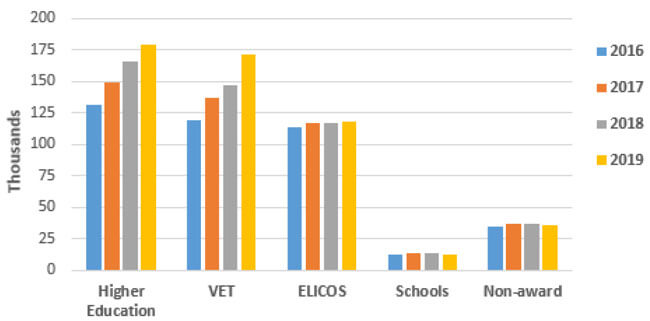Australia’s foreign enrolment up 10% in 2019
Full-year enrolment numbers for Australia reveal that the country’s foreign enrolment grew by just under 10% in 2019 (9.7% year-over-year). Total enrolment of visa-holding students reached 758,154, which reinforces Australia’s position as the world's second-leading study destination after only the United States. An accompanying analysis from the Australian Department of Education and Training (DET) adds that, “Commencements increased by 7.6% on 2018. This compares with the average annual commencements growth rate of 7.9% per year over the preceding five years.”
As the following chart reflects, the top five sending markets for Australia all grew last year, with India and Nepal driving much of the overall gains. Together, the top five senders accounted for nearly six in ten (57%) foreign students in Australia.

Outside of the top five senders, several emerging markets also saw notable gains, including Colombia (21,868 students in 2019, up 21.5% compared to the year before), Philippines (13,991 students, +90.8%), Pakistan (10,000 students, +26.5%), and Sri Lanka (8,065 students, +24.9%).
Growth by sector
As has been the case in recent years, the higher education and vocational education and training (VET) sectors accounted for most of the overall growth in 2019. This pattern is reflected in the following chart, which tracks commencements by sector over the past four years.

Overall, higher education numbers grew by 11% in 2019, and VET by 17%. ELICOS enrolment was essentially flat with +1% growth year-over-year, and both the schools and non-award sectors fell off in 2019 (-4% and -3% respectively).
Current context
That three in ten foreign students in Australia come from China will continue to raise questions about diversification and risk management for Australian educators this year, especially in light of the current Covid-19 outbreak and the extent to which it has disrupted mobility between China and Australia.
At this writing, on 26 February, a travel ban remains in place that prevents travel between the two countries. On 21 February, the ban was formally extended until 29 February. “Almost every student who is unable to enter Australia has now been contacted by their university,” said Universities Australia Chief Executive Catriona Jackson on the news that the ban would be extended until at least the end of the month. “They’ve been offered support, reassurance and revised plans for this semester.”
“It’s too early to know the full financial impact on universities, and on the Australian economy more broadly,” she added. “A lot will depend on how long travel restrictions continue, and the mitigating effect of flexible study options.”
For additional background, please see:
















